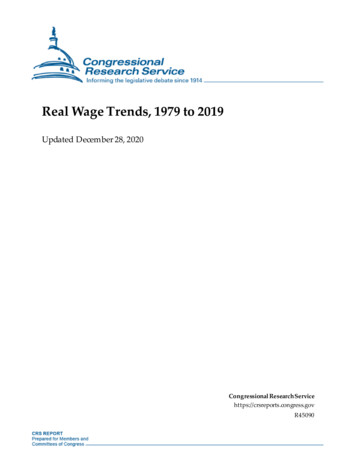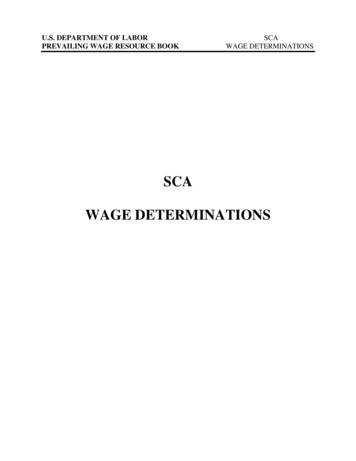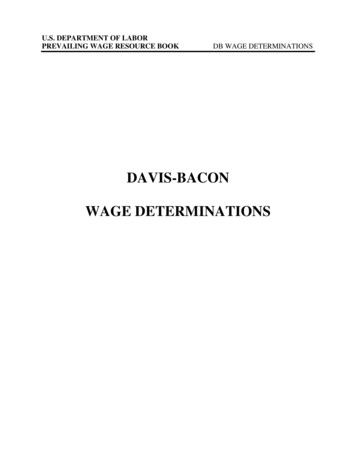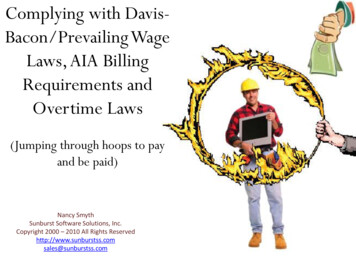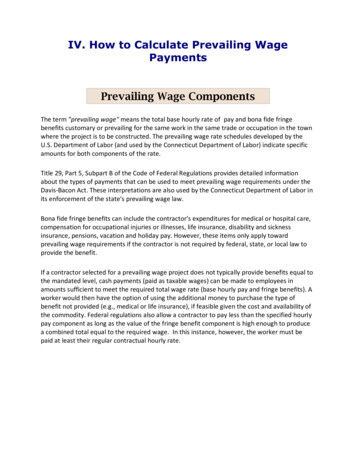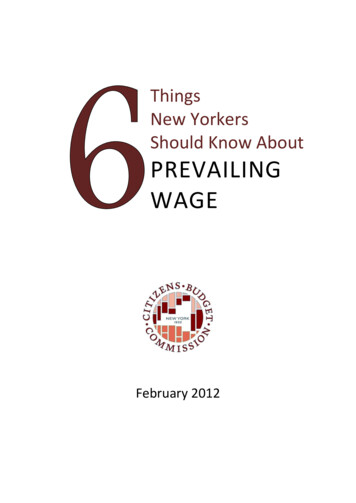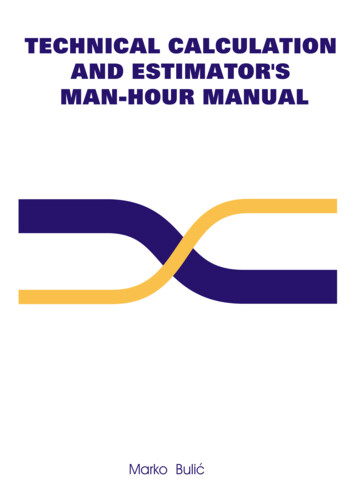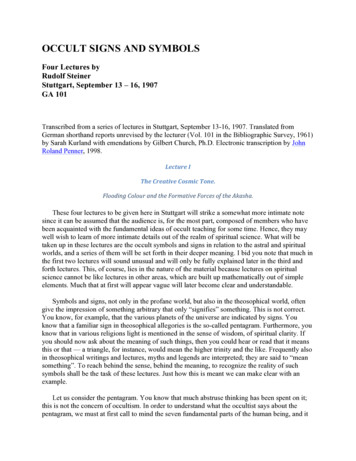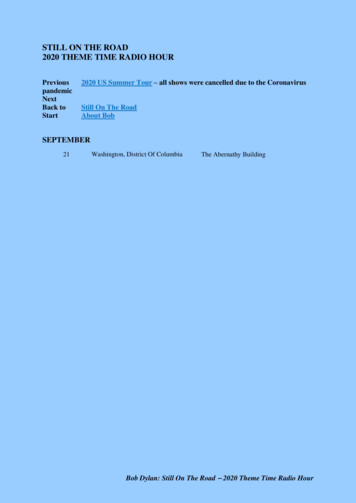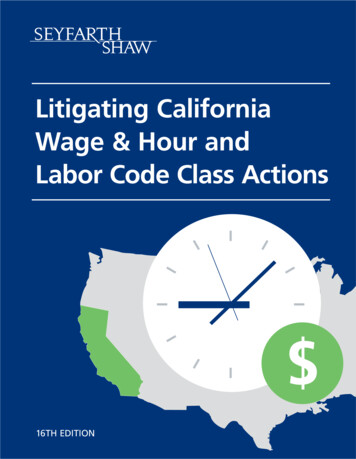
Transcription
Litigating CaliforniaWage & Hour andLabor Code Class Actions 16TH EDITION
Editor’s NoteThis work reflects thousands of hours of labor—expended over 16 years—by scores of Seyfarth Shawattorneys. While we cannot list them all here, their efforts are sincerely appreciated.This 16th Edition contains significant contributions from Co-Editors Leo Li, David Rosenberg, Michael Kopp,Monica Rodriguez, and Geoffrey Westbrook. Marjorie Soto also provided valuable input.David Kadue deserves special thanks for performing the unenviable task of editing the Editors. And thanks toAndrew Paley for his leadership and guidance, and to Sarah Guigliano for her production assistance.Christopher A. Crosman, Editor in ChiefImportant DisclaimerThis book is general commentary, not legal advice. We disclaim liability as to anything done or omitted inreliance on this publication. Readers should refrain from acting on any discussion in this publication withoutobtaining specific advice applying current law to particular circumstances. Thus, while we aim to provideauthoritative information, this book is not legal advice. (From a Declaration of Principles adopted by aCommittee of the American Bar Association and a Committee of Publishers and Associations.)Legal NoticeCopyrighted 2016. All rights reserved. Apart from fair use for private study or research permitted undercopyright law, no part of this publication may be reproduced or transmitted without the prior written permissionof Seyfarth Shaw LLP.Seyfarth Shaw LLP www.seyfarth.comLitigating California Wage & Hour Class Actions (16th Edition) 1
Table of ContentsI.Introduction and Overview .5II.Common Exempt Misclassification Claims .5III.IV.V.VI.A.Overview of State Overtime Law.6B.The Executive (Managerial) Exemption .7C.The Administrative Exemption .11D.The Outside Sales Exemption.16E.The Commissioned Salesperson Exemption.19Unlawful Deductions from Wages .20A.Generally .20B.Unlawful Bonus Plans .21C.Unlawful Commission Chargebacks .23Reimbursement of Employee Expenses .28A.The Duty to Reimburse Expenses Under Labor Code Section 2802 .28B.Reimbursement for Uniforms Under the Wage Orders.31Meal and Rest Period Claims .33A.Nature of Claims.33B.Debate over Whether One-Hour Payment Is a “Penalty”.35C.Meaning of “Provide” a Meal Period.36D.Limits on IWC’s Power to Alter Labor Code Meal Period Rules .42Tip-pooling.43A.Actions Alleging Tips Were Diverted to Co-Workers Who Did Not Earn Them .44B.Actions Alleging “Agents” of Management Wrongfully Took Tips .45C.The Future of Tip-pooling Cases Under California Law.47VII.Vacation/Paid Time Off Forfeiture .47VIII.Waiting Time Penalties .50IX.A.Generally .50B.Application to Fixed-Term and Temporary Employment.51Itemized Wage Statement Claims .53Seyfarth Shaw LLP www.seyfarth.comLitigating California Wage & Hour Class Actions (16th Edition) 2
X.XI.XII.XIII.XIV.California Minimum Wage Claims.56A.Wage Averaging Improper Under California Law .56B.The Conflict Between Piece-rate Formulas And The Requirement To Pay Minimum Wages.59C.Neutral Time-Rounding Practices Are Lawful .61D.Compensability of Time Spent in Security Checks .62California Labor Code Private Attorneys General Act .64A.General Scope of the Law.64B.Scope of the “Civil Penalty” Provisions .67C.Pursuing PAGA Claims Collectively Without Class Certification .68D.Release of PAGA Claims Through Class Settlement .70E.Wage Order Claims.71Unfair Competition Claims, Business & Professions Code Section 17200.73A.Former Law—Pre-Proposition 64.73B.Reform of the Law—Passage of Proposition 64 .75C.Proposition 64’s Restrictions on UCL Class Actions.76Class Action Fairness Act of 2005.77A.The Purpose of the Act.77B.General Requirements .77C.Removal Under CAFA.78D.Exceptions to CAFA Jurisdiction .83E.Waiver .84F.After Removal and Effect of Denial of Class Certification.84G.Settlement Process .86Class Certification.87A.General Requirements .87B.Class Certification in Exempt Misclassification Cases .89C.Subclasses .93D.Opt-In Classes.94E.Wal-Mart Stores, Inc. v. Dukes - The Supreme Court Shifts The Landscape Of ClassCertification .96F.In Comcast v. Behrend, The Supreme Court Emphasizes That It Meant What It Said InDukes .100G.The California Supreme Court Enforces Due Process In Duran v. U.S. Bank .103H.Easing of Class Certification Standards Post-Brinker .107Seyfarth Shaw LLP www.seyfarth.comLitigating California Wage & Hour Class Actions (16th Edition) 3
XV.XVI.I.Relitigation of Class Certification Denials .111J.Defense Motions to Deny Class Certification (“Vinole Motions”) .114Discovery Issues in Class Actions .116A.Disclosure of Class Member Names and Addresses to Allow Access to Potential Witnesses 116B.Discovery to Facilitate Location of Substitute Class Representatives .119C.Discovery Issues Regarding Putative Class Member Declarations .1241.Employers Must Approach Pre-Certification Communication With Their Employees WithCaution .1242.Protection Of Attorney Procured Witness Interviews From Discovery.126Class Action Settlement .128A.Generally .128B.Restrictions on Reversions of Settlement Funds .129C.Court Scrutiny of the Adequacy of the Settlement Amount.132D.Class Notice .135E.Objection to Settlements .135F.Individual Settlements with Putative Class Members .136XVII. Class Action Waivers and Arbitration .138A.Class Action Waivers and Arbitration Generally .138B.The Long And Winding Road To Iskanian .1391.California Supreme Court’s Decisions in Discover Bank and Gentry Effectively Negated ClassAction Waivers .1392.The U.S. Supreme Court Holds That the FAA Preempts California Law Restricting ClassAction Waivers .1413.California Courts Reach Conflicting Conclusions About Whether the Gentry Rules andUnconscionability Analysis Survived Concepcion.141C.The California Supreme Court Invalidates Gentry in Iskanian, but Carves Out Exception forPAGA Claims .143D.California Courts’ Reactions to the Iskanian Decision .1451.Federal District Courts in California Initially Declined To Follow Iskanian’s PAGA Exception,But the Ninth Circuit Put an End to that Debate.1452.California Appellate Court Declines to Apply Iskanian Reasoning to Broughton-Cruz Rule .1463.Applicability of Gentry’s Unconscionability Analysis Following Iskanian and Concepcion .146XVIII. Individual Liability.148Table of Authorities .151Index of Terms .178Seyfarth Shaw LLP www.seyfarth.comLitigating California Wage & Hour Class Actions (16th Edition) 4
I.Introduction and OverviewSince the turn of the century, there has been a huge increase in the number of class action lawsuitsalleging violations of California’s overtime laws or other Labor Code statutes and wage and hourregulations. Currently, several such class actions are filed every day in California courts.The reasons for this trend are essentially fourfold. First, California’s wage and hour law differs fromfederal law in various important ways. This means that an employer might be compliant with federallaw, but not California law. Second, California procedural rules make it easier to file a class actionor collective action. And the number of representative actions filed under the California PrivateAttorneys General Act, which are not required to meet class action certification standards, hasgreatly increased. In contrast, the federal Fair Labor Standards Act requires an “opt-in” procedurethat tends to restrict the size of classes as compared to the “opt-out” class action procedure used inCalifornia. Third, California’s unfair competition law allows claimants to borrow violations of otherlaws and extend the statute of limitations to four years, making class actions more lucrative. Fourth,many California Labor Code provisions allow for the recovery of attorney’s fees to a prevailingplaintiff, creating additional incentives to pursue litigation.California Labor Code class actions come in various shapes and sizes. Essentially, however, anyLabor Code violation that can be tied to a corporate policy could support a class action. For thatreason, plaintiffs in California continue to come up with new theories as to how wage and hourviolations may support class litigation. This publication reviews the most commonly filed wage andhour and Labor Code class and representative claims and the development of the law over the lastsixteen years. It does not, however, attempt to provide a comprehensive overview of Californiawage and hour law.Sections II through X of this edition address some of the most common types of class claims inCalifornia, such as claims for exempt classification, meal period violations, and denial of expensereimbursement. Sections XI and XII then address some peculiar provisions in California law thattend to expand potential damages recoverable in California class actions, such as the Labor CodePrivate Attorneys General Act and the Unfair Competition Law (“UCL”). Lastly, Sections XIII throughXVIII address various aspects of class action procedure in California—the rules governing classcertification, class discovery, class settlement, class arbitration, and individual liability.II.Common Exempt MisclassificationClaimsThe first wave of class claims filed against large California employers challenged the exempt statusof groups of employees holding the same job. In short, the plaintiffs’ counsel argued that theemployer had engaged in a common practice of misclassifying a group of employees as exemptSeyfarth Shaw LLP www.seyfarth.comLitigating California Wage & Hour Class Actions (16th Edition) 5
from overtime, thus entitling all employees in the group to back overtime pay, interest, andassociated statutory penalties.1 The following discussion addresses some of the issues that havearisen concerning the misclassification of employees under the various available exemptions.A.Overview of State Overtime LawBefore January 1, 2000, the California Industrial Welfare Commission (“IWC”) was the bodyauthorized by statute to set overtime requirements. It acted in a quasi-legislative capacity,promulgating a series of “Wage Orders” that set rules for wages, hours, and workingconditions that differed slightly from one industry to another. The IWC eliminated dailyovertime from the Wage Orders in 1997.2 In response, in 1998 the Legislature passed AB60 which amended the Labor Code to provide for daily overtime and to enshrine variousemployee protections into the Labor Code so that they could not be altered by the IWC.3The Wage Orders are still in effect, but the IWC is precluded from promulgating rules withinthe Wage Orders that are inconsistent with the Labor Code itself.4Under Labor Code Section 510, employees are entitled to one and one-half times theirregular rate when they work more than eight hours in a single day, more than forty hours ina workweek, or during the first eight hours of the seventh straight day of a singleworkweek.5 Employees are entitled to double time when they work more than twelve hoursin a single day or beyond the eighth hour of the seventh straight day of a single workweek.These rules apply to non-exempt employees in California in every industry.6 These rules1Punitive damages are not recoverable when liability is premised solely on Labor Code wage and hour violations. Brewerv. Premier Golf Props., 168 Cal. App. 4th 1243, 1252 (2008).2Collins v. Overnite Transp. Co., 105 Cal. App. 4th 171, 176 (2003).3See, e.g., Lab. Code § 510 (daily overtime requirement) and Lab. Code § 226.7 (meal and rest period requirements).Note that Labor Code section 510 does not apply to employees covered by a valid collective bargaining agreement if“the agreement expressly provides for the wages, hours of work, and working conditions of the employees” and“provides premium wage rates for all overtime hours worked and a regular hourly rate of pay for those employees of notless than 30 percent more than the state minimum wage.” Lab. Code § 514; see also Vranish v. Exxon Mobil Corp., 223Cal. App. 4th 103 (2014) (affirming trial court ruling that employer: (1) properly paid overtime under the terms of acollective bargaining agreement; and (2) was exempted from Labor Code section 510 pursuant to Labor Code section514).4Collins, 105 Cal. App. 4th at 178-80 (Wage Orders and Labor Code should be read together to understand scope ofwage and hour regulation of California employees).5Note that employers may assign employees to work schedules that differ from company’s designatedworkweek/workday and base overtime calculations on the designated workweek/workday as long as the schedule is notestablished for the purpose of evading lawful overtime requirements. Seymore v. Metson Marine, 194 Cal. App. 4th 361(2011).6However, employees and employers may specifically agree in advance to a “specific mutual wage agreement” thatprovides a guaranteed salary covering both base hours and a specific number of overtime hours. The requiredelements of such an agreement are: “(1) the days that [employee] would work each week; (2) the number of hours[employee] would work each day; (3) that [employee] would be paid a guaranteed salary of a specific amount; (4) that[employee] was told the basic hourly rate upon which his salary was based; (5) that [employee] was told his salarycovered both his regular and overtime hours; and (6) the agreement must have been reached before the work wasperformed.” Archiega v. Dolores Press, Inc., 192 Cal. App. 4th 567, 571 (2011) (quoting Ghory v. Al-Lanham, 209 Cal.App. 3d 1487, 1491 (1989)).Seyfarth Shaw LLP www.seyfarth.comLitigating California Wage & Hour Class Actions (16th Edition) 6
also apply to non-resident employees who perform work in California for Californiaemployers.7Individual employees have a private right of action for unpaid overtime. Typically, a plaintiffinvokes a private right of action by alleging violation of Labor Code Section 510 or aprovision of the governing IWC order. Such a claim does not depend on the Fair LaborStandards Act (“FLSA”) or other federal law. A prevailing plaintiff may recover attorney’sfees for an overtime claim,8 but California law, unlike the FLSA, does not provide a remedyof double damages for willful overtime violations.9 In a private action for unpaid overtimecompensation under the Labor Code, the statute of limitations reaches back to three yearsbefore the date the lawsuit is filed in court.10B.The Executive (Managerial) ExemptionOne issue frequently raised in misclassification class actions is that a proposed class ofexempt managers—most often “working managers” in a retail establishment—do notqualify for the “executive” (aka “managerial”) exemption. The FLSA and California lawcontain similar executive exemptions, but California’s is more restrictive in key respects.California requires that an “executive” employee be paid a higher level of compensationthan required under the FLSA.11 The salary must be set at a level at least twice theminimum wage, which is currently 10.00 per hour in the State of California.12 Accordingly,to qualify for the exemption, a manager must now be paid 37,440 per year. A manager7The California Supreme Court in Sullivan v. Oracle, 51 Cal. 4th 1191 (2011), held that California overtime laws apply toout-of-state employees who perform work within the state. Further, the Sullivan court held that overtime work performedby out-of-state employees within California can serve as the basis for a claim under California’s unfair competition law.Cal. Bus. & Prof. Code § 17200 (“UCL”). But the Sullivan court also held that FLSA violations as to out-of-stateemployees outside California cannot serve as the basis for a California UCL claim. Although the Sullivan court explicitlylimited its decision to “the circumstances of this case,” the plaintiff’s bar may argue its reasoning suggests that similarconclusions may result for non-California-based employers. The Sullivan court declined to opine on the differentburdens that a non-California-based employer may face in applying California overtime laws to nonresident employeesworking in California, but the plaintiff’s bar will undoubtedly seek to obtain judicial rulings that the Sullivan court’s conflictof laws analysis suggests no reason why a different conclusion would result for non-California-based employers.8The California Court of Appeal has held that only the prevailing employee, and not the prevailing employer, may recoverattorney’s fees in an action for overtime pay or for unpaid minimum wages. Earley v. Superior Court, 79 Cal. App. 4th1420 (2000).9But see Lab. Code § 1194.2 (providing double damages for minimum wage violations).10As explained infra, this statute of limitations can be extended to four years through the pleading of a companion claimunder the state Unfair Competition Law, Bus. & Prof. Code § 17200, et seq.11The revised FLSA regulations that went into effect on August 23, 2004, increased the minimum salary from 250 perweek to 455 per week. Even under this revised minimum, California’s minimum remains higher than the FLSA’sminimum.12The California minimum wage rose to 10.00 per hour on January 1, 2016, and will rise to 10.50 per hour on January1, 2017, for employers with more than 25 employees. The federal minimum wage is currently 7.25; employees workingwithin California are generally subject to the higher state minimum wage.Seyfarth Shaw LLP www.seyfarth.comLitigating California Wage & Hour Class Actions (16th Edition) 7
who does not meet the threshold compensation test is automatically disqualified from theexemption.The other requirements are that the manager (1) must have the power to hire and fire, ormake recommendations on those topics that are given particular weight; (2) must superviseat least two full-time equivalent positions; (3) must “primarily” be engaged in managerialduties; and (4) must “customarily and regularly” exercise discretion and independentjudgment.13Most litigation in California arises out of element (3) above, because the CaliforniaSupreme Court in Ramirez v. Yosemite Water Co.14 held that an employee meets element(3) only when the employee spends more than half of the work time on exempt duties. Bycontrast, under the FLSA’s executive exemption, the employer need only establish thatmanagement is the employee’s “primary duty,” which focuses on the relative importance ofthe duty rather than just the amount of time devoted to the duty.15Aside from its emphasis on the percentage of work time devoted to exempt duties, therehas been little California case law explaining precisely which duties qualify as exempt“managerial work.” Since July of 2000, however, the Wage Order has expresslyincorporated by reference the then-existing FLSA regulations defining “managerial”duties.16 Accordingly, federal authority construing those specific regulations is highlyrelevant in interpreting the California executive exemption.17Some examples of exempt work set forth in the federal regulation are interviewing,selecting and training employees, setting and adjusting pay rates and work hours, directingwork, keeping production records for subordinates, evaluating employees’ efficiency andproductivity, handling employee complaints, disciplining employees, planning work,13See IWC Wage Order 1-2001(1)(A)(1); Nordquist v. McGraw-Hill Broad. Co., 32 Cal. App. 4th 555, 573 (1995)(“‘Discretion and independent judgment’ within the meaning of IWC Order No. 11-80 involves the comparison ofpossible courses of conduct, and acting after considering various possibilities. It implies that the employee has thepower to make an independent choice free from immediate supervision and with respect to matters of significance . . .[meaning matters] of substantial significance to the policies or general operations of the business of the employer.”).1420 Cal. 4th 785 (1999).15Id. at 797; see also Baldwin v. Trailer Inns, Inc., 266 F.3d 1104, 1113-16 (9th Cir. 2001) (although store managersspent less than one-half their time on duties that met the federal executive exemption, they still qualified as exemptbecause management was found to be their “primary” or most important duty).16See Whiteway v. FedEx Kinko’s Office & Print Servs., Inc., 2007 U.S. Dist. LEXIS 61239; 12 Wage & Hour Cas. 2d(BNA) 1503 (N.D. Cal. Aug. 21, 2007) (citing IWC Wage Order 7-2001 § (1)(A)(1)(e) and noting that it incorporates thefederal definition of management as set forth in 29 C.F.R. § 541.102).17See Whiteway, 2007 U.S. Dist. LEXIS 61239, at *22 (relying on federal cases construing 29 C.F.R. § 541.202 tointerpret California executive exemption); see also Bldg. Material & Constr. Teamsters Union v. Farrell, 41 Cal. 3d 651,658 (1986) (“Federal decisions have frequently guided our interpretation of state labor provisions the language of whichparallels that of federal statutes.”); Alcala v. Western Agric. Enters., 182 Cal. App. 3d 546, 550 (1986) (“It has been heldthat when California’s laws are patterned on federal statutes, federal cases construing those federal statutes may belooked to for persuasive guidance.”).Seyfarth Shaw LLP www.seyfarth.comLitigating California Wage & Hour Class Actions (16th Edition) 8
determining techniques to be used, distributing work, deciding on types of materials,supplies, machinery and tools to be used or merchandise to be bought, stocked, and sold,controlling the flow and distribution of merchandise and supplies, and providing foremployee safety.18Seyfarth Shaw has successfully defended many cases where liability turned on whether aparticular job duty qualifies as exempt or non-exempt. From our experience in such cases,it is important to carefully analyze those that have addressed similar duties under the FLSAregulations that are expressly incorporated into the Wage Orders. For example, wedefended a case for a large HMO that turned on whether working pharmacy managerswere misclassified as exempt executives. One of the main duties of the managers was tocheck the work of other pharmacy employees for medication errors in filling prescriptions—a duty also performed by licensed pharmacists who were not managers. We obtainedsummary judgment by relying on numerous cases holding that (1) a manager checkinganother employee’s work for compliance with a standard qualifies as exempt “supervision”19and (2) it does not alter the analysis that non-managers also perform the same task.20Another federal regulation expressly incorporated into the IWC Wage Orders is (former) 29CFR Section 541.108, which includes in the definition of exempt work all work that is“directly and closely related to exempt work.” The FLSA regulation explains that thisconcept allows seemingly non-exempt duties to be treated as exempt duties:[It] brings within the category of exempt work not only the actualmanagement of the department and the supervision of theemployees therein, but also acti
The reasons for this trend are essentially fourfold. First, California’s wage and hour law differs from federal law in various important ways. This means that an employer might be compliant with federal law, but not California law. Second, California procedural rules ma
